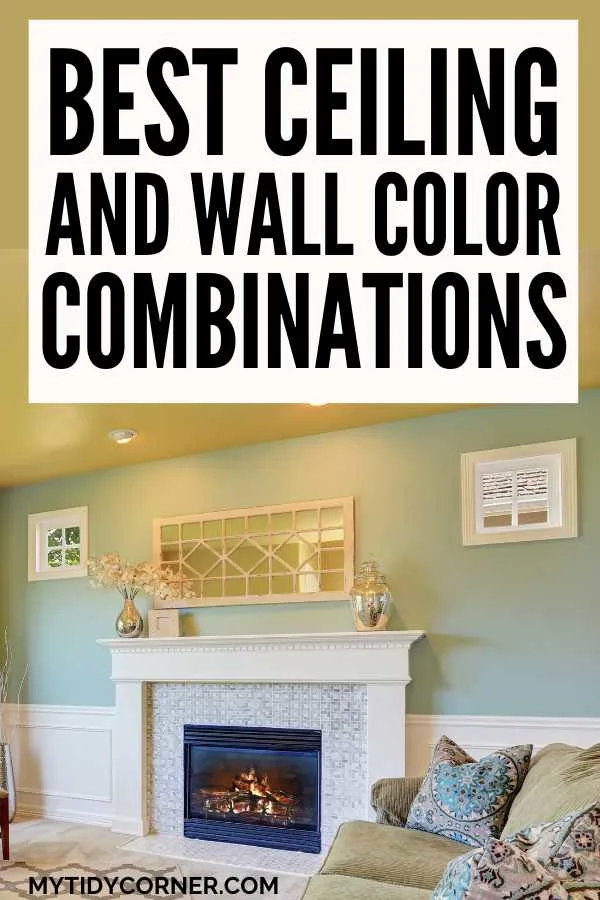Knowing the best wall and ceiling color combinations will help you make an informed choice for your home.
For the longest time, I only ever noticed the ceiling when I got into bed at night, exhausted and wide-eyed after a long busy day. But psychologists and interior designers emphasize that the color of the ceiling can impact the feel of a room and change our moods dramatically.
Let’s look at the best wall and ceiling color combinations.
The best wall and ceiling color combinations are monochrome drenching, tonal shading, or color contrasts. Color wrapping creates harmony and cohesion while toning shades add interest. Create a dramatic effect by contrasting wall and ceiling colors, light on dark, or color on color.
I never underestimate the impact of color in our homes – it can transform a room’s character, create the illusion of space, and energize and uplift us.
While we often mull over the color we’re painting walls, we tend to forget the “fifth wall” or ceiling. You can go for a safe white, but there are endless gorgeous combinations of wall and ceiling colors.

Monochrome Walls and Ceiling Color Combination
The first option is to paint the walls and ceiling the same color.
All White
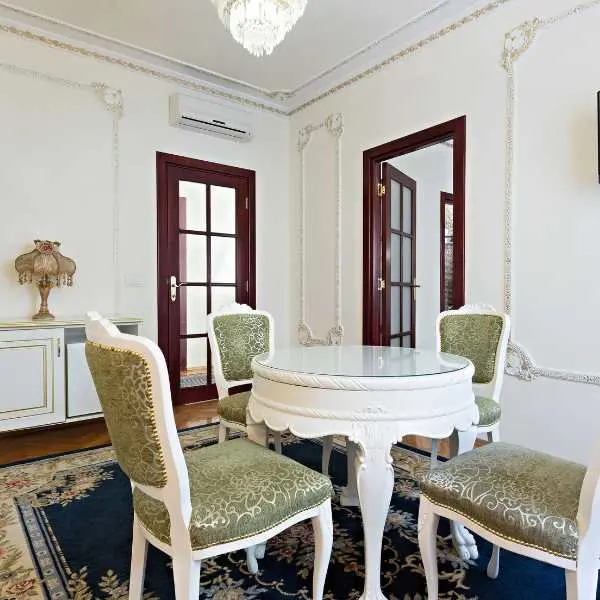
Let’s get white out of the way first. It’s practical, sensible, but a little dull.
However, there is an argument for painting both walls and ceiling white or off-white. Consider an all-white combination in the following cases.
If a room is small and low-ceiling, white or off-white can create a feeling of space and airiness. A white ceiling always creates the illusion of height because it reflects more light than the walls. Adding white furnishings is elegant and fresh.
Chilly, north facing rooms always need more light, and a creamy white ceiling and walls radiate warmth. Avoid icy whites, as they can look flat and sterile. Ivory, cream, beige, and linen shades are ideal.
If you’re on a budget and/or in a rental property, white walls and ceilings are cheaper and easier to repaint and touch up. It’s also easier to hide painting errors with white paint.
Color Drenching
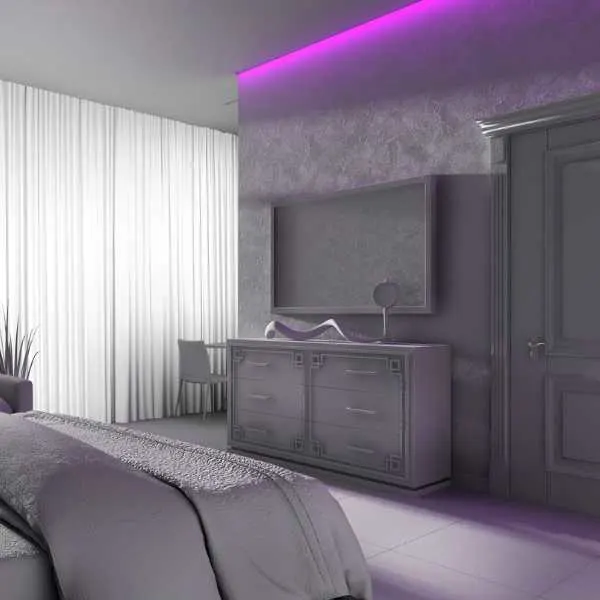
Another approach to matching walls and ceiling is color wrapping or drenching. This means painting the entire room the same color, including walls, ceiling, doors, skirting, and molding.
Color wrap when you’ve chosen a bold, moody, or exciting color, as it creates a cohesive and elegant impression.
In smaller rooms, the cohesion of color blurs the distinction between walls and ceiling, making the room seem bigger and the ceiling higher.
Color wrapping with dark colors like gray, blue, or black creates a cozy, cocoon-like effect, ideal for bedrooms.
If you have an attic with a dormer ceiling, hide the odd angles and uneven slopes by painting both the walls and ceiling the same color. A monochrome effect will also enlarge the space, while a warm shade will make it cozy.
Color drenching is on-trend, so introduce a trending color like lavender. This design statement will update a traditionally appointed room. Highlight architectural features through a different finish (e.g., gloss) or color.
Tonal Ceiling and Walls Color Combinations
A second option for wall and ceiling color combinations is to use toning shades of the same color. This approach creates a flowing effect without the intense overwhelm of a single color.
Remember that shades of a color do not always match – ensure that the undertones are either all warm or cool for the best effect.
Warm Color Combinations
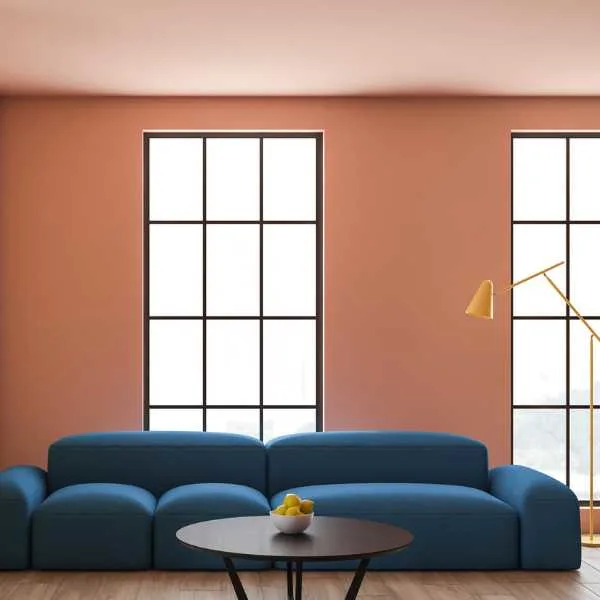
Warm colors include red, yellow, orange, and pink, while colors with warm undertones are cream, beige, brown, and purple.
These colors are perfect for rooms saturated in natural light. Warm tones are inviting and welcoming, so choose these shades to brighten a chilly, north-facing room.
Painting the ceiling a lighter shade (e.g., pale violet) than the walls (dark purple) enhances and increases the amount of natural light in a room; you can go 20% to 50% lighter for brightness. A lighter ceiling gives the illusion of loftiness.
You can paint the ceiling in a more saturated shade for sunny and spacious rooms. (You may also want to read this post on the best south facing room paint colors.)
If you’re nervous about matching colors, ask the paint store to mix your original color with 50% white.
Here are some exciting tonal combinations:
- Coral pink walls with gentle terracotta ceiling
- Buttery walls and a cheerful yellow ceiling
- Pumpkin orange walls and an apricot ceiling
- Tan walls and a beige ceiling
Warmer tones work well with a Southwest interior style or a Mediterranean aesthetic. They complement dark wood and create a cozy atmosphere.
Cool Color Combinations
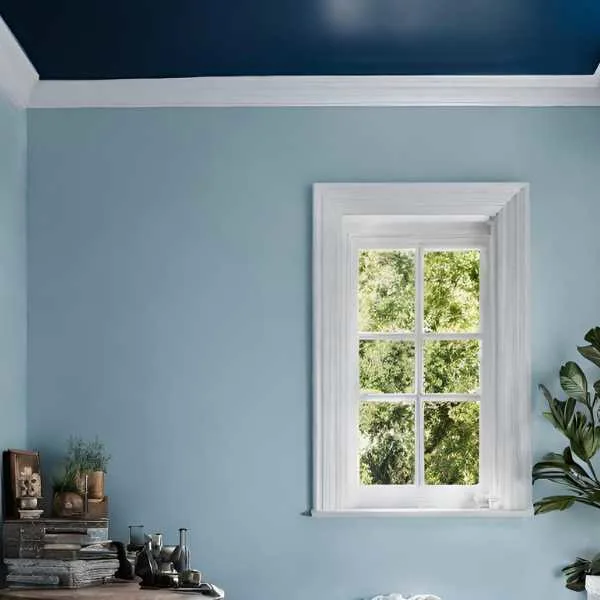
Colors on the cooler end of the spectrum include blue, green, and gray, and have a calming, serene feel.
Lighter cool-toned colors tend to recede, helping to make smaller rooms look bigger. If you have a small, low-ceiling room, or a poorly lit east or north-facing room, go for a lighter shade on the ceiling.
However, in north-facing rooms, take care with cool colors, as they can look flat and cold. Use a color swatch to see the color’s appearance under natural and artificial light.
Blue is particularly effective as it creates a sky-like effect. Possible combinations are:
- Sky blue ceiling and royal blue walls
- Aqua ceiling and turquoise walls
- Midnight blue ceiling and pastel blue walls
Bolder shades of blue and green are perfect for bedrooms and living rooms. For example, use on-trend sage as a ceiling color with darker green walls. Or flip the combination around and have a mossy green ceiling with minty walls for a dramatic, striking effect. Echo the darker green on skirting boards, dado rails, and door frames.
Cooler tonal combinations work well for coastal or beach-style interiors, romantic French boudoirs, or charming English country aesthetics.
Contrasting Color Combinations for Walls and Ceiling
Your third alternative for wall and ceiling color combinations is to use contrasting colors, whether light and dark, two pastel shades, or two dazzling brights. Each combination will create a different vibe.
Colored Walls and White Ceiling
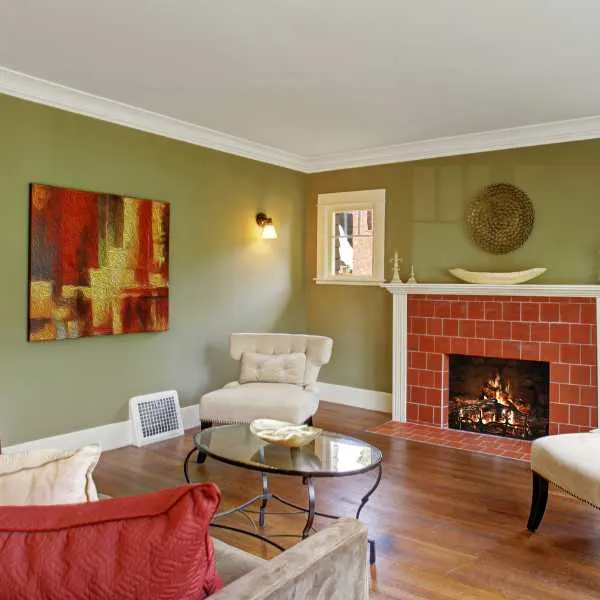
The most common wall and ceiling color combination is to have bolder colored walls with a white (or light-colored neutral) ceiling.
This combination effectively makes a ceiling seem higher as the walls are grounded, particularly if the walls are deeply pigmented with brown, olive green, or purple.
Go for this combination if you love more intense colors but have small or north-facing rooms that need to look airy and open.
A white ceiling works well with all colors. The greater the contrast between the walls and ceiling, the more dramatic the effect. Consider red and white, black and white, or silver and white for glamorous, sophisticated interiors.
You can also use a white ceiling for any design aesthetic, as it is crisp and elegant atop Boho blues, vintage mustard, or coastal greens.
Light Walls and Bold Ceiling
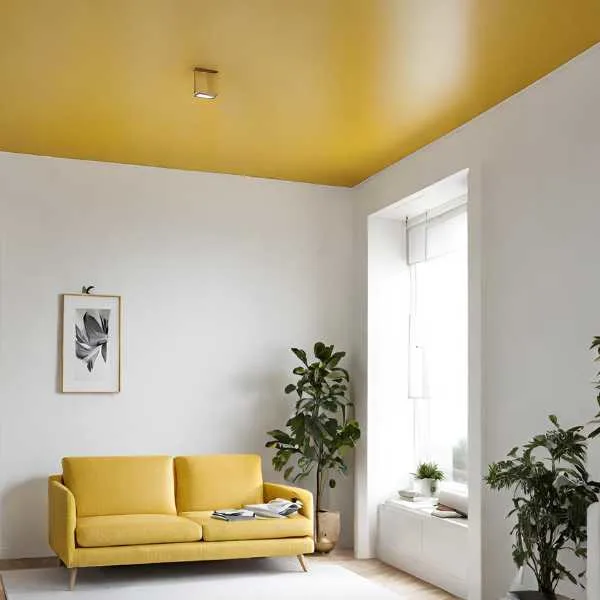
The opposite of having a lighter ceiling is to paint your ceiling a darker or bolder color than the walls. Imagine white walls with a chocolate brown ceiling, gray walls with a black ceiling, or beige walls with a midnight blue ceiling.
Introduce a bright color into your home by painting the ceiling a vivid shade and the walls a light neutral. This combination is refreshing and cheerful, with yellow or orange adding a pop of color against white walls.
Painting the ceiling a darker color immediately makes it seem lower and the room more intimate. Combining a gray or dark blue ceiling with white walls, therefore, works well in home theater rooms and bedrooms that you want to be cozy and inviting.
Bolder-colored ceilings are unexpected and immediately noticeable, making a colored ceiling a great choice to highlight a feature or architectural effect. Add further contrast by painting the trim in a neutral color.
The darker the ceiling, the more dramatic the contrast. Use a striking color combination like charcoal and white in contemporary and industrial designs.
To prevent the ceiling from looking like an afterthought, pick up the color elsewhere in the room, such as in artwork, the floor, a rug, or soft furnishings.
Avoid this combination in small, low-ceiling rooms where the ceiling will look heavy and claustrophobic. Dark colors absorb light rather than reflect it.
Colored Walls and Colored Ceiling
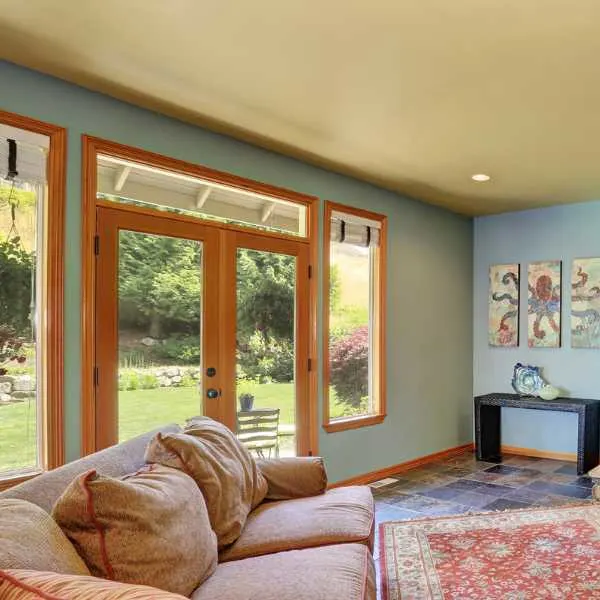
For those who embrace the artsy and eclectic, an obvious combination is to paint the walls and ceiling completely different colors. Ideally, the undertone of both colors should match so that there is harmony in intensity.
The endless combinations are as vast as your imagination. Here are some possibilities.
Combine two jewel-like shades (e.g., teal and purple) for a vintage vibe.
Use two softer shades (e.g., blush pink and pistachio) for elegance and charm.
Combine earthy colors on the wall and ceiling (e.g., greige and moss green).
Final Thoughts on the Best Ceiling and Wall and Paint Combinations
While painting a ceiling white is the safest and most common option, changing up the color has an immediate effect. Drenching a room in a single color, neutral or bright, makes a space appear larger.
Using toning shades of a color is harmonious and elegant. Contrasts in walls and ceiling are most striking, with lighter ceilings adding height and darker ceilings coziness.
Which of the wall and ceiling color combinations is your favorite? Leave your comment below.
